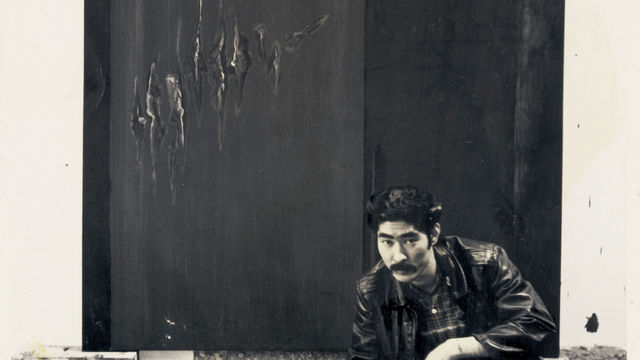
Ron Miyashiro
Ron Miyashiro is a jewelry maker, painter, and assemblage artist whose practice gained momentum in Los Angeles in the early 1960s, soon after he moved there from Honolulu in 1957. After taking private art lessons, in 1958 he began attending Chouinard Art Institute, where he met Joe Goode, Larry Bell, Ed Bereal, Daniel LaRue Johnson, Llyn Foulkes, and Ed Ruscha. Miyashiro was one of the four artists included in the now legendary War Babies exhibition at the Huysman Gallery in 1961, organized by the gallery's director, Henry Hopkins. In its brief history, the Huysman Gallery, which provided an alternative to the dominant Ferus Gallery, located across the street on La Cienega Boulevard, exhibited the work of a number of young artists, including Bell, Goode, and Ruscha.
The War Babies exhibition was advertised by a controversial poster that included a photograph, by Jerry McMillan, of the four artists grouped around a table covered in an American flag. The men were posed to highlight stereotypes of their racial and religious backgrounds. As Hopkins wrote, "The African American [Bereal] holds the cliché symbol of his race, a watermelon, the Jew [Bell] a bagel, the Asian [Miyashiro] a bowl of rice, and the Catholic [Goode] a tin of herring. Four specific minority groups sharing a symbolic meal."# The poster was attacked for desecrating the American flag; however, that particular aspect was not intended to be the focal point of the image. The exhibition was a political gesture advocating for "integration and internationalism"# and challenging the established norm of racial stereotyping and identity politics in postwar America.

Miyashiro's focus on painting and assemblage continues to this day. His Concord series, which he worked on throughout the 1960s, consists of works made of wood, cardboard, papier-mâché, and found objects. The series had its genesis when Miyashiro recovered some wooden boxes and a set of small crucifixes from the garbage. He took the elements of these forms as he found them and built cohesive structures out of the various parts. The armatures are wooden, with cardboard surfaces painted in a dark lacquer. Papier-mâché and tiny crucifixes add texture and ornamentation. In each, a narrow plane sharply bisects the boxy base of the objects; in this way, they come to resemble the armored vehicles of war. Yet the title provides a compelling juxtaposition. The pieces are named after the street where Miyashiro's studio was located; the term concord also resonates with the process of bringing together discarded materials to produce a harmonious new form. The title is furthermore a social commentary on the politics of war and civil unrest roiling Los Angeles and other urban centers in the United States and abroad in the 1960s. "Concord" suggests an agreement, and although the term speaks quite literally to the unity of the composition of the work, it more resoundingly articulates a consciousness that promotes union within the dissensus of social life.
Miyashiro was featured in the Yes on 10 exhibition organized by Melvin Edwards in 1964. The two artists developed a friendship and would later share a studio when Miyashiro moved to New York City in 1966. Miyashiro continues to work in assemblage and painting. His compositions maintain the foundation of his early works—a combination of abstract painting with wooden sculptural forms that bisect the canvases and resemble the prominent features of objects in flight.
—Kalia Brooks
Selected Exhibitions
Southern California Painting and Sculpture Annual, Los Angeles County Museum of Art, 1959.
War Babies: 1937–1961, Huysman Gallery, Los Angeles, 1961.
Yes on 10: Los Angeles Images, Little Gallery, San Bernardino Valley College, 1964.
Collage and Assemblage, Los Angeles Institute of Contemporary Art, 1975.
Lost and Found in California, Shoshana Wayne Gallery, Santa Monica, 1988.
Circa 1962, Cardwell Jimmerson Gallery, Culver City, California, 2010.
Selected Bibliography
Glicksman, Hal. "Collage and Assemblage." Los Angeles Institute of Contemporary Art Journal, no. 6 (June–July 1975).
Willick, Damon. "L.A.'s Art Historian: Henry T. Hopkins, 1928–2009." X-TRA: Contemporary Art Quarterly 12, no. 3 (Spring 2010).
Wilson, William. "A Bag of Precious and Weird Junk." Los Angeles Times, April 14, 1975.
Selected Links
Ron Miyashiro biography page, Pacific Standard Time at the Getty Center, Los Angeles.
Ron Miyashiro Wikipedia page.
Getty Center, "Joe Goode, Larry Bell, Ron Miyashiro, and Jerry McMillan speak about the exhibition War Babies, 2010–11" video, Pacific Standard Time at the Getty Center, Los Angeles.
Chouinard Foundation, "Ron Miyashiro Interview," uploaded to YouTube December 19, 2011.


